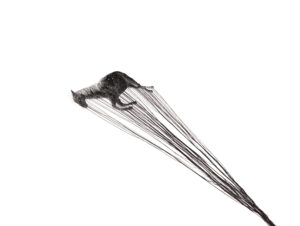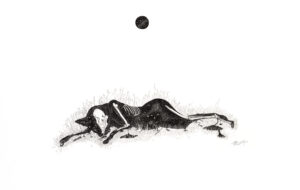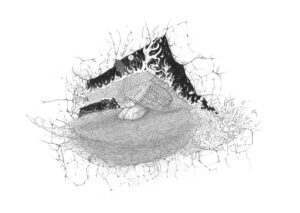September 06, 2021
Transformation, the latest exhibition at (Not) Sheep Gallery, features work from Japanese artist Izumi Yoyoyama that explores and embraces human struggles within the context of nature. Yokoyama meditatively threads the ephemeral and the eternal while evoking a nostalgia for the unknown, and the dark and transcending apparitional motifs in her works are characterized by the presence of absence in her use of negative space. We recently spoke with her about her inspiration, the themes in her work, using different mediums to express herself, and what it means to be shown in the Short North Arts District.
What influences informed the pieces that make up your show, Transformation?
Different experiences through different phases have influenced the works that are in this show. My epileptic childhood, birthing, motherhood, kinship with animals in the high desert, and other painful personal experiences brought the lights and new understanding. I was always fascinated by animals in nature. I love that they don’t seem to care anything about the meaning of their existence. When I moved to the middle of nowhere outside Taos, New Mexico, the vast nature and star-filled night sky swallowed my desire to question much about the purpose in this modern life. Desert ravens, coyotes, and wild horses that I saw daily said nothing, but told me everything I needed to know then. I began to explore and embrace human struggles within the context of nature through my art.
Your work often depicts the natural world and the relationship between living and dying. Why are these themes important to you?
Japanese culture and rituals raised me to respect the existence of everything and every being. I am trying to acknowledge and grasp the detailed process of living and dying, especially those uncomfortable and unspoken. Both decaying carcasses and full blooming cherry blossoms are equally authentic and true, and these juxtapositions often coexist in my artworks as in the wilderness.
How does working in different mediums (drawing, sculpting, and others) help you to express your ideas?
It became significant in my art practice to have different mediums. I often enjoy seeing the drawings by the sculptors that they created in their planning phase. I draw the way I picture sculpture or installation in the space; when viewing a small intricate drawing that depicts large-scale sculpture, you may have a more comprehensive visual experience keeping the intimate proximity. I draw thin lines to respect the fragility. When you are in front of my installation in a gallery or museum space, you become more aware of your existence and physical relationship to the art. Both experiences are intimate, and I need to practice different mediums to explore the ideas. During my graduate program at the San Francisco Art Institute, I drew my installation ideas with inkpen on paper. My ideas then were often to wrap objects, houses, or entire streets with strings. I used the same intricate drawing style for those idea drawings to draw each line of threads. I started to make more drawings to express the ideas for my installation and sculptures
Part of the visual impact of some of your work is your use of negative space; how does this help to express your ideas?
The concepts are characterized by the presence of absence in my use of negative space. As void guides me to breathe and process, I enjoy the significant space around my subject. I grew up learning and practicing Japanese calligraphy (Sumi-ink brush writing on white rice paper) for many years. The negative space seemed as important as the dark ink-filled character.
What does it mean to you to have your work shown in a gallery located in the Short North Arts District?
I am honored to have this opportunity to show in the Short North Arts District. The history of this area is fascinating and powerful. I respect that there have been growing movements by the gallery owners, artists, and the community. I read about how they thrived to survive and support art in life, especially since the 1980s. Caren Petersen is an incredible gallery owner who understands the relationship between artists, the gallery, and the community. It is challenging to sustain the supportive and growing relationship between those three. I am looking forward to feeling the creative vibe on Short North Arts District’s streets and am grateful to be sharing my works from northern New Mexico in the inspiring art scenes.
Transformation by Izumi Yokoyama will be on view at (Not) Sheep Gallery, located at 17 W. Russell St, through September 26, 2021.
The artwork at the top of the page is a pen and ink drawing on paper completed in 2019 and titled “Ascension.”




